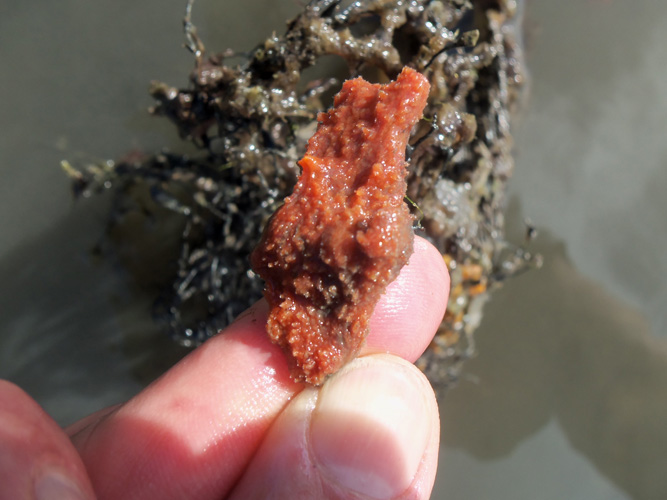Discovery of a previously unobserved sponge growing on a manmade oyster reef at the southern end of our island is prompting a scientist at Harbor Branch Oceanographic Institute to launch a comprehensive survey of sponges throughout the Indian River Lagoon.
The scientist hopes to determine how widespread the newly seen sponge is, what other sponges live in the lagoon, and what the role of sponges is in the lagoon’s ecology.
St. Lucie County artificial reef chief Jim Oppenborn was surprised when he came across the motley-looking invertebrate growing in the shallow waters of Wildcat Cove near the SEAL Museum. It was the first time he had seen a sponge growing on a manmade oyster shell reef.
Oppenborn turned the unknown sponge over to Harbor Branch ecologist/assistant professor Dr. Andia Chaves-Fonnegra and her colleague Dr. Cristina Diaz, who identified it as Suberites aurantiacus – commonly found in the Gulf of Mexico, Bahamas, Caribbean and along the Brazilian coast, but never before seen in the Indian River Lagoon.
Sponges, which have been around for hundreds of millions of years, are sedentary creatures that pump and filter large quantities of water and feed on bacteria and tiny plankton. They provide the ecological benefits of filtering pollutants; providing food and shelter for other marine animals; shoring up reefs; and serving as sources of up to half of all anti-cancer drugs in current use.
Now Chaves-Fonnegra is on the hunt to determine whether the sponge – which doesn’t appear on the Smithsonian Institution’s index of 14 lagoon sponge species – is native or exotic, how widespread it is, and whether it hurts or helps the lagoon ecosystem.
“It’s possible it was here [all along] but not identified,” Chaves-Fonnegra said. “Is this species suddenly here, or was it here before but nobody noticed? We are trying to study it to see how good or bad it could be for the environment.”
Inspired by the discovery, the scientist and her colleagues and students are embarking on a lagoon-wide survey this summer to find out what sponge species currently inhabit the lagoon; how abundant they are; and what their role is in the ecosystem.
They want to learn what habitats the new sponge lives in, such as seagrass, oyster reefs, sand flats, or mangroves. They also plan to perform experiments on the sponges – initially to see what salinity range they prefer and, if they get funding, to learn whether they harm or help their preferred habitats and how they respond to algal blooms.
The researchers plan to revise Harbor Branch’s inventory of more than 3,500 specimens and display Suberites aurantiacus in the aquarium at the Harbor Branch visitors center.
By the end of the summer, Chaves-Fonnegra hopes to be able to report her findings to the public and help local resource managers like Oppenborn determine how the sponge figures into their lagoon research and restoration initiatives.
“It opens a lot of new questions that I am very interested in,” Chaves-Fonnegra said.

